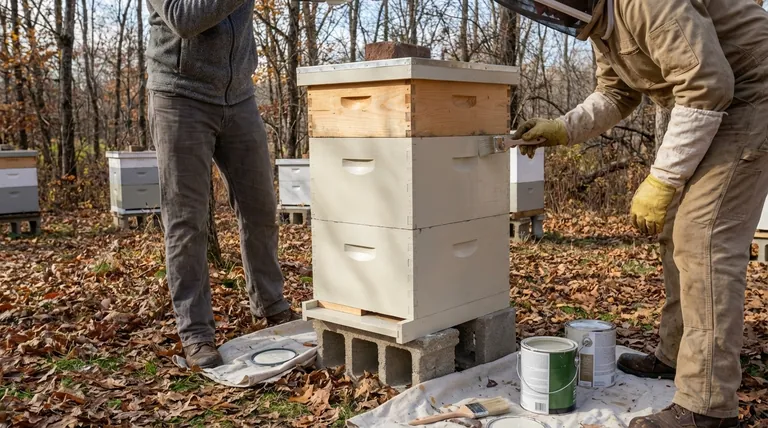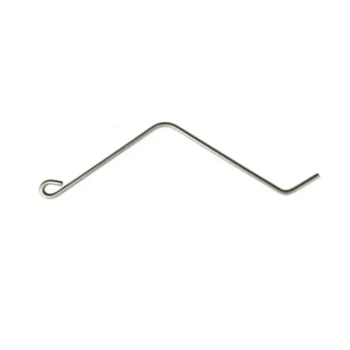The ideal time to paint a beehive is when it is new and empty, well before you introduce a colony of bees. This allows the paint to dry and cure completely without exposing the bees to any fumes. However, it is possible to paint an occupied hive by choosing a day when the weather is cool enough to keep the bees inside but warm and dry enough for the paint to cure properly.
The core principle of painting a beehive is not just about timing, but about safety. Your goal is to protect the wooden hive from the elements while ensuring the bees are never exposed to wet paint or harmful fumes from the curing process.

Why Painting Beehives is a Necessary Task
Painting your hives is not for aesthetics; it is a critical maintenance step that directly impacts the health and longevity of your colony's home. Unprotected wood is highly susceptible to weather damage.
Protecting Your Investment
A beehive is an investment in both money and time. Unpainted wood will absorb moisture from rain and humidity, leading to rot, warping, and decay. This shortens the lifespan of your equipment, forcing costly replacements.
Ensuring a Healthy Hive Environment
A structurally sound hive is a dry hive. Painting creates a waterproof barrier that prevents moisture from seeping into the wood, which helps to prevent the growth of mold and mildew inside the hive that could harm the bees.
The Gold Standard: Painting a New, Unoccupied Hive
The safest and most effective approach is to paint all hive components before they are ever used. This method eliminates all risks to the bees.
Gaining Complete Coverage
When painting a disassembled hive, you can easily coat all exterior surfaces, including the difficult-to-reach edges and joints. This ensures a complete, protective seal against the weather. Remember to never paint the inside of the hive or the top and bottom edges of the boxes where they make contact.
The Importance of Curing Time
The most significant advantage of painting a new hive is allowing for adequate curing time. "Dry to the touch" is not the same as fully cured. A cured paint has finished "off-gassing"—the process of releasing volatile organic compounds (VOCs). Allowing several days or even a week for the paint to cure ensures no harmful fumes will be trapped inside with the bees.
Repainting an Occupied Hive: A Practical Guide
Over time, hives will need a fresh coat of paint. While not ideal, painting an active hive is manageable if you follow specific precautions to protect your colony.
Finding the Perfect Weather Window
The key is to find a day that meets two conditions: the bees are inactive, and the paint can dry. This is typically a cool, clear, and dry day in the early spring or late fall. The temperature should be cool enough (below 50°F / 10°C) to encourage the bees to stay clustered inside, but warm enough to meet the paint's minimum application temperature (usually found on the can).
Minimizing Bee Disruption
Work quickly and efficiently. If possible, temporarily block the hive entrance with a screen or entrance reducer to prevent bees from coming out and getting stuck in the wet paint. As soon as the paint is no longer tacky, remove the block to restore ventilation and access.
Use the Right Kind of Paint
Always use a zero-VOC or low-VOC exterior water-based latex paint. These paints are safer for the bees and the environment. Lighter colors are preferred as they help reflect solar heat during the hot summer months, reducing stress on the colony.
Understanding the Trade-offs and Risks
Painting an active hive introduces risks that must be managed. Understanding them is crucial for protecting your bees.
Risk 1: Trapping Fumes
If paint is applied too late in the day or if the weather turns damp, it may not cure properly. The uncured fumes can be drawn into the hive and harm the bees. Proper timing and ventilation are essential.
Risk 2: Sealing the Hive
Be extremely careful not to let wet paint drip into and seal the hive entrance or any upper entrances. A blocked entrance can lead to overheating and suffocation.
Risk 3: Agitating the Colony
Working on an active hive can be disruptive. Any vibrations or disturbances may agitate the bees, causing them to become defensive or break their winter cluster, which could be fatal in cold weather.
Making the Right Choice for Your Goal
Your approach should be dictated by the status of your hive and your primary objective.
- If your primary focus is maximum safety and durability: Paint your hive components when they are new and allow them to cure for at least a week before introducing bees.
- If your primary focus is maintaining an existing, active hive: Wait for a cool, dry day in the off-season (early spring or late fall) when bees are clustered and your paint can dry quickly.
- If your primary focus is quick touch-ups on minor damage: You can perform small repairs on any calm, mild day, working carefully to avoid disturbing the entrance or bees.
Properly maintaining your hive is a direct investment in the long-term health and success of your colony.
Summary Table:
| Scenario | Best Time to Paint | Key Considerations |
|---|---|---|
| New, Unoccupied Hive | Before introducing bees | Allows for complete curing; safest for bees. |
| Occupied Hive | Cool, dry day in early spring or late fall | Bees are clustered; paint can dry properly. |
| Paint Type | Always | Use zero-VOC or low-VOC exterior latex paint. |
Protect Your Apiary Investment with the Right Equipment
Maintaining your hives is essential for a thriving apiary. HONESTBEE supplies commercial apiaries and beekeeping equipment distributors with the durable, high-quality supplies needed for effective hive management. From hive bodies to protective gear, our wholesale-focused operations ensure you get the reliable equipment your business depends on.
Ready to strengthen your beekeeping operation? Contact HONESTBEE today to discuss your wholesale needs and discover how our products support the health of your colonies and the success of your business.
Visual Guide

Related Products
- Wholesales Dadant Size Wooden Bee Hives for Beekeeping
- Long Langstroth Style Horizontal Top Bar Hive for Wholesale
- Professional Drop-Style Hive Handles for Beekeeping
- Automatic Honey Flow Beehive 4 Frame Mini Hive for Beekeeping
- Professional Engraved Round Hive Number Tags for Beekeeping
People Also Ask
- What is beekeeping equipment? Essential Tools for Commercial Apiaries & Distributors
- What are the advantages of wooden bee hives? Superior Bee Health & Beekeeper Flexibility
- Why were wooden hives traditionally preferred? For Natural Beekeeping Aligned with Bee Biology
- What should beginners consider when purchasing beekeeping equipment? A Guide to Essential Starter Gear
- What types of products are available for beekeeping needs? Essential Equipment for Apiaries & Distributors



















